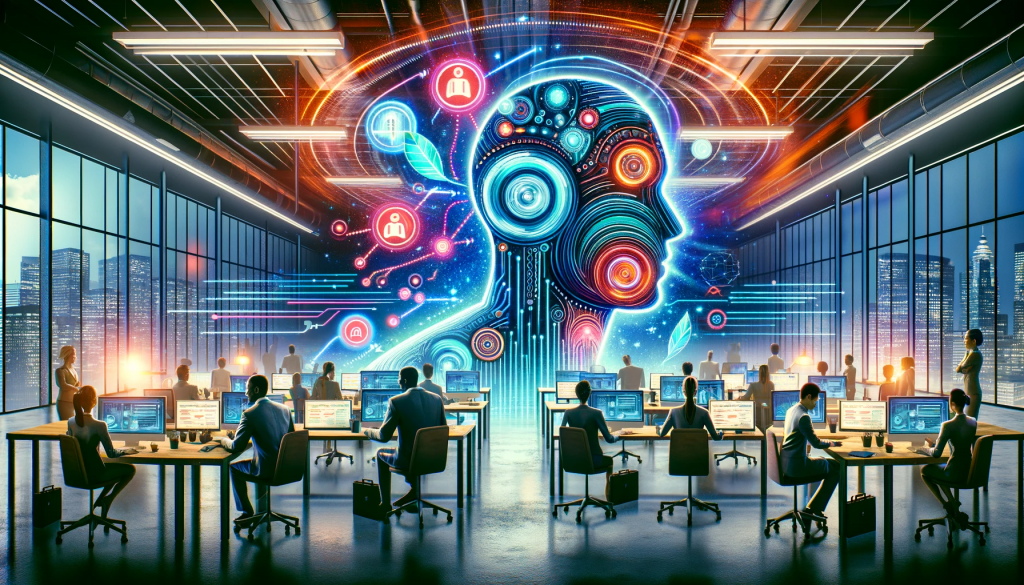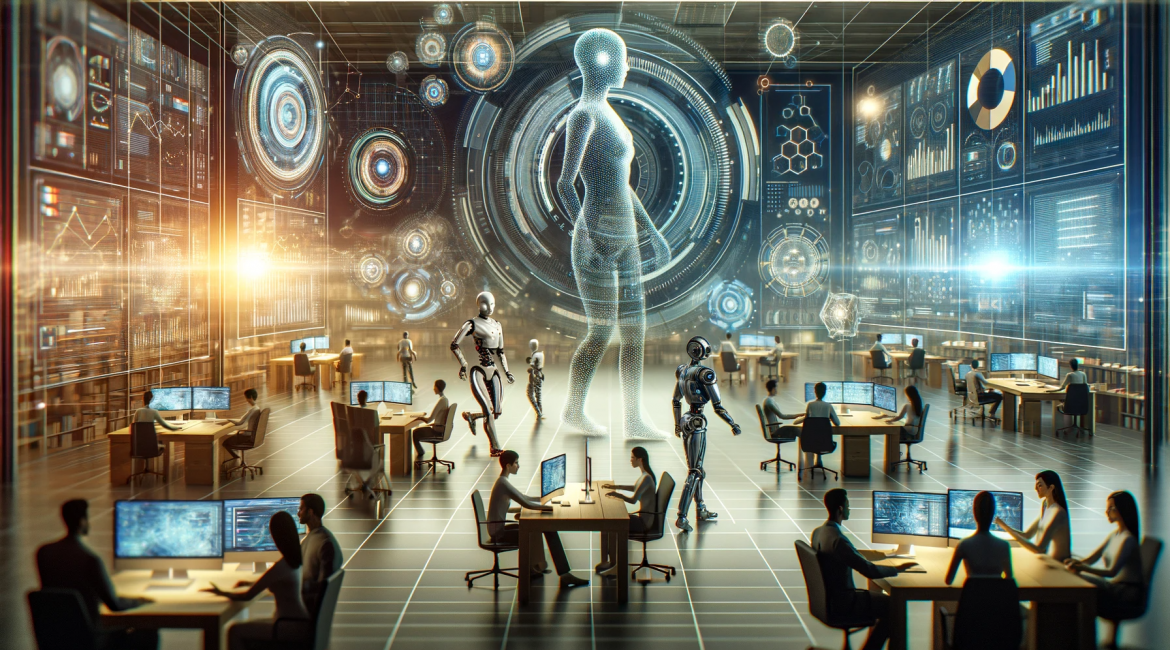Introduction
The integration of Artificial Intelligence (AI) in the workplace is no longer a futuristic concept but a present reality. As we tread further into the 21st century, the synergy between humans and AI is reshaping the labor landscape, promising efficiency and innovation. However, this integration comes with its own set of challenges and ethical considerations. Balancing technological advancement with the protection of human labor is not just a corporate responsibility; it’s a societal imperative.
The Evolution of AI in the Workplace
The Evolution of AI in the Workplace: A Deeper Dive
AI’s journey into the workplace is a narrative of groundbreaking progress and transformative impact. The seeds of AI were planted by visionaries like Alan Turing, whose groundbreaking work laid the conceptual foundation for machines mimicking human intelligence. This leap from theory to application has seen AI evolve from a nascent idea in computer science to a robust tool reshaping industries.
Early Applications and Growth
The initial forays of AI in the workplace were modest, focusing on automation in sectors like manufacturing. These early applications, while basic, demonstrated AI’s potential to increase efficiency and reduce human error. As technology advanced, so did AI’s capabilities, transitioning from rudimentary tasks to more sophisticated roles.
AI’s Inflection Points
Significant inflection points in AI development have marked its journey. The introduction of machine learning algorithms, which allow AI systems to learn and improve from experience, was a game changer. This advancement enabled AI to move beyond pre-programmed tasks and adapt to new situations, leading to more nuanced and complex applications in various fields.
Revolutionizing Decision-Making
One of AI’s most significant impacts in the workplace has been in decision-making processes. AI algorithms can analyze vast amounts of data, identify patterns, and provide insights that were previously unattainable. This capability has transformed sectors like finance, healthcare, and logistics, where data-driven decision-making is critical.
Ethical and Practical Considerations
With AI’s growing influence, ethical and practical considerations have come to the forefront. The need to balance AI’s efficiency and capabilities with job preservation is a significant challenge. AI’s ability to perform tasks traditionally done by humans raises concerns about job displacement, necessitating a thoughtful approach to its integration.
Sustainable Job Creation
Despite fears of job loss, AI’s evolution also presents opportunities for new job creation. The rise of AI has spurred demand for new skill sets, such as AI ethics, machine learning expertise, and data management. This shift underscores the importance of adapting workforce skills to the changing landscape, turning potential displacement into an opportunity for growth and innovation.
However, this progress raises a crucial question: How do we balance AI’s capabilities with the need to preserve human jobs?
AI and Job Displacement: A Historical Perspective
The evolution of technology in the workforce is a saga of adaptation and opportunity. From the Industrial Revolution’s steam engines and mechanized looms to the AI-driven workplaces of today, each technological leap has reshaped the labor landscape. Initially, the advent of machinery sparked fears and resistance, symbolized by the Luddites during the Industrial Revolution. Yet, over time, these innovations created new industries and job opportunities, particularly in fields like electrical engineering and automotive manufacturing.
Today’s AI era mirrors this historical pattern. AI’s foray into cognitive tasks challenges the notion of exclusively human jobs. It’s redefining roles across various sectors, from customer service bots to finance algorithms, blurring the lines between human intellect and machine efficiency. However, the narrative isn’t solely about job displacement; it’s about the evolution of work. AI is creating new roles such as data scientists and AI ethics specialists, and it’s redefining existing ones, allowing humans to engage more in creative and strategic tasks by automating routine functions.
This ongoing technological journey in the workforce isn’t a zero-sum game of human versus machine. Instead, it’s an ever-evolving partnership, where each advancement brings new opportunities for human creativity, efficiency, and job creation. Embracing this change is key to unlocking a future where AI enhances human potential and opens new horizons in our ever-evolving job landscape.
In the context of AI, the displacement concern is amplified due to the technology’s ability to perform complex cognitive tasks – a domain previously thought to be exclusively human.

Creating New Job Categories with AI
Despite fears of job displacement, AI also holds the potential to create new employment opportunities. As AI takes over repetitive and mundane tasks, it frees human workers to engage in more creative, strategic, and complex problem-solving roles. This shift necessitates a redefinition of job roles and a focus on skills development.
For example, the rise of AI has created a demand for data scientists, AI trainers, and ethicists, roles that hardly existed a decade ago. This evolution echoes the sentiments of economists like Joseph Schumpeter, who coined the term “creative destruction” to describe the process of transformation that accompanies innovation.
Balancing AI Integration with Ethical Considerations
The integration of AI into the workplace must be underpinned by strong ethical considerations. This involves ensuring that AI systems are transparent, accountable, and free from biases. Companies like Google and IBM have laid down AI ethics principles that emphasize fairness, transparency, and privacy.
Moreover, organizations must consider the impact of AI on employee well-being. The fear of being replaced by AI can cause anxiety among workers. Hence, transparent communication and participatory approaches in AI implementation are crucial.
The Role of Education and Professional Development
Adapting to a workplace where AI plays a significant role requires a shift in education and professional development. There’s a growing need for educational institutions to include AI literacy in their curricula. Additionally, businesses must invest in continuous learning and upskilling programs to help their workforce adapt to new AI-driven roles.
This approach aligns with the lifelong learning model, championed by experts like John Dewey, emphasizing the continual development of skills and knowledge throughout one’s career.
Conclusion
The integration of AI in the workplace is a complex but inevitable progression. Balancing AI’s benefits with the protection of human labor requires a multifaceted approach, involving ethical AI deployment, job role evolution, continuous education, and an emphasis on human-centric AI design.
As we navigate this new era, it’s crucial to remember that AI is not a replacement for human intelligence but a complement to it. The ultimate goal should be to harness AI’s potential to enhance human work, not replace it. In doing so, we can create a future where AI and humans coexist in a mutually beneficial ecosystem, driving innovation and progress while preserving the dignity and value of human labor.




